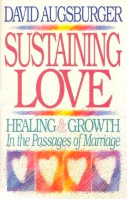|
MARRIAGE ONE |
MARRIAGE TWO |
MARRIAGE THREE |
MARRIAGE FOUR |
| GOALS |
DREAM
We marry to fulfill the Dream - personal, marital, career and communal dreams. |
DISILLUSIONMENT
The Dream fails us. Or we sacrifice the marital to gain the career and so on. |
DISCOVERY
We discover reality beyond the Dream, we discover each other. |
DEPTH
We develop depth in our selves, our marriage, our life together. |
| COMMUNICATION |
EXPECTATION
We communicate out of expectations of what is meant, needed, wanted, obligated, necessary. |
MANIPULATION
We manipulate by persuading, seducing, coercing, evading and avoiding to get what we want. |
INVITATION
We discover that true communication is invitation and work toward equality. |
DIALOGUE
We develop dialogue with genuine mutuality and equality in our communication. |
| FEELINGS |
EXCUSE
We are afraid of, embarrassed by, cautious with, concealed about or unaware of feelings. |
EXPLODE
We risk sharing feelings, but find them painfully threatening, often uncontrolled, unfocused, confused and confusing. |
EXPRESS
We own and express feelings with freedom and with both candor and caring. |
EXPERIENCE
We flow with both our feelings and thoughts. |
| DIFFERENCES |
ACCOMMODATE
We tolerate, accommodate, overlook differences to avoid conflict and obey the Dream. |
ELIMINATE
We seek to eliminate the objectionable differences in the partner by demanding change. |
APPRECIATE
We discover the differences are creative, necessary parts of each of us and our marriage. |
CELEBRATE
We delight in our differences and develop them in each other. |
| CONFLICT |
AVOID
We avoid conflict as disruptive and destructive of the Dream. |
ATTACK
We explode with frustrated feelings, seek to eliminate differences through fighting, bargaining, pressuring. |
ADJUST
We discover more fair ways of fighting; we seek mutually satisfactory solutions more quickly. |
ACCEPT
We accept conflict as a healthy process and utilize it to work for mutual growth. |
| INTIMACY |
DEPENDENT
Intimacy is dependent on romance, on the moment, on the other's responses, on his/her "acting as prescribed." |
INDEPENDENT
Intimacy is touch and go, intense when things are going well, absent when there is tension or threat. |
INTERDEPENDENT
Intimacy now becomes truly possible as autonomy is balanced with solidarity. |
INTIMATE
Intimacy now develops freely in emotional, mental, social and spiritual levels. |
| ROLES |
COMPLEMENTARY
Relationships are shaped by complementary "fitting" of partner's strengths and weaknesses. |
SYMMETRICAL
Relationships are competitive, adversary, tit-for-tat struggles to claim personal identity. |
PARALLEL
Relationships achieve balance, equal freedom and responsibility. Autonomy and intimacy are protected. |
INTERTWINED
Relationships are mutual, with both partners secure and satisfied whether near or far. |
| MEANING |
HOPES
Hope shaped by the Dream are largely false hopes which must eventually die for love to become truly alive. |
HOPELESSNESS
Hopes fade, falter and fail us. Life together becomes empty and alienated. |
HOPEFUL
Hope rises as we find that beneath the old hopes there is deeper, richer meaning to our life together. |
HOPE
True hope has emerged and pushes us onward from healing in the past, pulls us forward with the promise of the future. |
